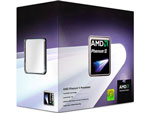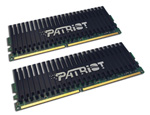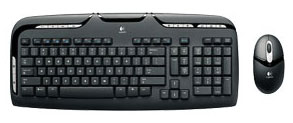AMD HTPC
Everyone asks for HTPC component recommendations, but those potential HTPC buyers seem almost impossible to please. Perhaps this is because the HTPC, more than any other computer class, is a very personal machine. It needs to meet the specific needs and demands of the end users, who vary widely in what they plan to do with their new HTPC.
So let's first talk about our build concept for these two HTPC configurations, which remain very similar to the recommendations in our last entry guide. We are assuming the user already has the HDTV or monitor he plans to feed, along with a sound system for that HDTV. The motherboards we recommend can reasonably feed audio signals for your Blu-ray movies, but they are not integrated audio amplifiers. Since most end-users are on cable or satellite for TV, we will not include any TV tuner recommendations. In other words, our HTPC recommendation is a "white box" recommendation. We do understand that some users want more detail and more options in our HTPC recommendations so we plan to do an expanded HTPC Buyers' Guide in the future.
Of the many possible uses for an HTPC, the majority of end-users store, play, and stream movies with their HTPCs. Thus, that is where we have concentrated our recommendations. In general, the processing power in both systems has increased since our December 2008 guide, but as performance increases costs have fortunately continued to drop. This is particularly true in our new case recommendation from Antec, which provides a "component look" case and silent 80 Plus certified 380W power supply for $120.
| AMD HTPC System | ||
| Hardware | Component | Price |
| Processor | AMD Phenom II X3 710 Deneb (Tri-core 2.6GHz, 45nm, 3x512KB L2, 6MB Shared L3) |
$119 |
| Cooling | CPU Retail HSF | - |
| Video | On-Board | - |
| Motherboard | ASUS M3N78-EM GF8300 Micro ATX | $90 |
| Memory | Patriot Viper Model PVS24G6400LLK 4GB DDR2-800 4-4-4 ($52 less $25 Rebate) |
$27 |
| Hard Drive | WD Caviar Green WD10EACS 1TB 32MB cache - OEM | $90 |
| Optical Drive | LG BD/HD DVD / 16x DVD+/- RW GGC-H20L - Retail | $110 |
| Audio | On-Board | - |
| Case | Antec NSK2480 Black/Silver Micro ATX Case Includes 80 Plus Certified 380W PSU |
$120 |
| Power Supply | Earthwatts 380W Included with Case | - |
| Base System Total | $555 | |
| Input | Logitech Cordless Desktop EX110 USB RF Wireless Keyboard and Optical Mouse |
$30 |
| Operating System | Microsoft Vista Home Premium SP1 (for System Builders) | $99 |
| Complete System Bottom Line | $685 | |
 |
The CPU chosen for the AMD HTPC is the tri-core Phenom II X3 710 with 6MB of shared L3 cache. You get the expanded processing power of the Phenom II, which is always useful in an HTPC, at the same price as the older Phenom CPU chosen in the last HTPC guide. The three cores each run at 2.6GHz, each has a 512KB L2 cache, and you get a shared 6MB L3 cache - the same L3 cache size shared on higher end quad-core Phenom II processors. We hesitate to call a Phenom II X3 CPU a low-end chip, but this is certainly the most reasonable Phenom II you can buy. However, it has plenty of power to take your AMD HTPC anywhere you choose to go.
 |
With DDR2-800 still a reasonable option these days, we equipped the HTPC with 4GB of fast CAS4 Patriot Viper memory. We aren't interested in overclocking this HTPC (though it's technically still possible), and spending additional money on even higher performance RAM just doesn't make sense. 4GB of memory, however, does make perfect sense in an HTPC box.
 |
The $90 ASUS M3N78-EM is based on the NVIDIA GeForce 8300 chipset. The board features one PCI-E x16 slot, one PCI-E x1 slot, two PCI slots, 8GB memory support, NVIDIA Gigabit LAN, 7.1 HD audio, 12 USB ports, five 3Gb/s SATA ports with RAID support, IEEE 1394a, one eSATA port, HDMI/DVI/VGA output, and full support for Phenom 140W processors. This board offers overclocking capabilities along with being a top-notch HTPC board. We highly recommend the GF8200/8300 series for the HTPC market due to hardware accelerated Blu-ray playback, multi-channel LPCM output, and very good application performance.
 |
As we discussed in the HTPC introduction we did not include a TV tuner in the configuration since most end users are now distributing their cable and satellite feeds. Few users, therefore, have any real need for a TV tuner card. If you truly need a Digital TV tuner, one interesting option on the TV tuner side is the HD HomeRun from Silicondust USA. This dual HDTV tuner/recorder functions over a network and provides ATSC/QAM support. The price of $159 is more than many other options, but this is arguably a more flexible overall solution - particularly with the mandated move to digital from analog.
What's the point of having an HTPC if you don't have a lot of storage space? To that end, we selected a newly affordable 1TB (1000GB) Western Digital Caviar Green WD10EACS SATA hard drive at just $90. The WD Green features an energy saving design and we found to be among the quietest drives we have ever evaluated. For an HTPC, silence is paramount, and this WD Green will not disappoint. The WD Green is a bit slower than 7200RPM 1TB drives, but the real performance difference is very minor - especially if you're only interested in HTPC duties like video storage and playback.
Seagate also makes a super-reliable 1TB drive optimized for video storage and retrieval called the Seagate SV35.3 ST31000340SV 1TB at $150. This "video" Seagate features 24x7 reliability with >1 million hours MTBF and improved read/write reliability. For those willing to pay the small premium for this drive, the "video" Seagate would be a good choice. The Seagate includes a 5-year warranty.
 |
The Optical Drive is certainly an upgrade to the entry and budget systems since a reasonable HTPC requires Blu-ray playback capabilities. The LG Blu-ray drive fits the bill without breaking the bank. It provides 6X Blu-ray playback and the fastest recording and playback of DVD and CD media. The current price is around $110, but this drive sometimes goes on sale for $100 so look out for specials.
There are also Blu-ray options from Lite-On for less than $100 and a 6X Blu-ray player at $105. We do not have much experience with this Lite-On drive, but Lite-On drives in the past have proved reliable. That would make the Lite-On 6X Blu-ray a more reasonably priced alternative where every penny counts.
 |
Our choice for the HTPC case is the Antec New Solution NSK2480 with its audio component look, and it includes an extremely flexible design for a micro ATX motherboard. The case features an Earthwatts 80 Plus 380W power supply and two side-mounted 120mm TriCool 3-speed fans. It supports two front-accessible 5.25" drives and two internal 3.5" drives. An adjustable internal baffle system lets you direct the airflow for best cooling.
If you prefer a small cube case, the Lian Li PC-V350B is a gem of a small black aluminum case. The Lian Li is also a great choice for those who prefer a cube instead of a component look.
 |
Since most will place their HTPC near their HDTV or big screen monitor, a wired keyboard and mouse are not very useful in most setups. More often, you'll want to control the PC from across the room, so we selected a wireless RF Logitech keyboard and mouse. At just $30 for the pair, the Logitech Cordless Desktop EX110 USB RF wireless package is a great value. This is also the HTPC preferred RF wireless set, which does not require "line of sight" that is needed for IR wireless.
The final price of the AMD HTPC comes to just $685. That is a bargain considering the tri-core Phenom II CPU, 4GB of memory, and 1TB hard drive, all housed in a quiet Antec HTPC case with an 80 Plus certified PSU. You can certainly spend even less on a basic HTPC box, but we doubt you can build a more powerful or quieter system for the same money.










65 Comments
View All Comments
Wesley Fink - Thursday, May 14, 2009 - link
That is the way it is on the Intel side. We have to go up to the $169+ range to get VT on Intel and quite frankly, maybe 1% of people might ever run XP mode in Win7.If running the Windows Virtual PC under Windows 7 for XP Mode is important to you, then moving to the E8x00 range or the E6x00 are the best VT options. That would blow the Budget out the door, and make the Intel selections not competitive in the Budget Range.
Do you work for AMD? This is a really minor nag for the vast majority of our readers, and as I'm sure you aware, for a Budget PC if this feature really matters to you then go for an AMD system in the budget price range.
nycromes - Thursday, May 14, 2009 - link
I think their point was/is that there is no mention of it in the article. It is nice to know what you get and what you don't get for these kind of systems. I don't think many will need the VT feature, but it could have still been presented in the article for those that might need it. I wouldn't change the recommendations, but just a small blurb about it would probably suffice.Of course, if they read the comments, there is plenty of mention of it so it doesn't really matter anymore.
Gary Key - Thursday, May 14, 2009 - link
We had strict budget numbers to meet for this guide. We had to select the entry level Intel processors due to cost and still provide a decent set of components around it. We added a statement about VT support to the processor descriptions.HelToupee - Thursday, May 14, 2009 - link
This will be a boon to those using non-Microsoft OSes for our HTPC's XBMC, my HTPC OS of choice has supported nVidia's accelerated video playback for quite awhile now. Unfortunately, players have not been able to take advantage of AMD/ATI's Linux drivers due to AMD/ATI being slow to release specs/headers. Acelleration on nVidia is supported in most major Linux video players by default, all you have to do is have the nVidia binary driver installed.kleinwl - Thursday, May 14, 2009 - link
It's probably worth mentioning that a core i7 makes a great cpu in an HTPC. While it blows the budget, if you are looking to upscale DVDs using ffdshow (or the like) to fit your 52" screen, I would suggest that you do not skimp on the cpu power. While ffdshow is a nightmare to get properly configured (thousands of options, no consistent recommendations), once you do, you can have a viewing experience close to that of an oppo. However, ffdshow can be a resource hog, and thus I recommend pushing the cpu spec as high as you can aford.Spoelie - Friday, May 15, 2009 - link
1. Size of the screen is not directly related to resolution (and thus scaling power needed). There are large plasma screens with the same resolution as a 17" LCD. A modern 52" TV will 'only' have a resolution of 1920x1080, and as such BR will need no scaling, and decoding DVDs is such a light load that there's plenty left for upscaling.There's a reason media tanks do not use super-fast general purpose cpus. They just aren't needed for playing back stuff, even with scaling.
The only valid reason to push cpu power is for transcoding.
2. Ideal = low power, noise, heat, consumption. Not something one would associate with an i7.
Nowadays, even though I have a HTPC, I'm of the opinion you're better of with a media server/transcoder somewhere in a back room and a networked media tank next to the screen instead of a single device to do both tasks.
HOOfan 1 - Thursday, May 14, 2009 - link
Just an FYInecrohippy - Thursday, May 14, 2009 - link
biostar t-series motherboard amd athlon x2 3.0ghz 4gb ram 500watt moduler psu decent case nvidia gtx geforce 260 896mb video card xp pro $600 after rebate $750 in the first place changed cpu from 3ghz to 4.5ghz a great gaming rig for the money....smoken. I had keyboard,mouse,and 19inch viewsonicmrubermonkey - Thursday, May 14, 2009 - link
With these Intel systems people will not be able to do hardware virtualization of Windows XP from within Windows 7, but people with AMD systems should be alright.JarredWalton - Thursday, May 14, 2009 - link
I think you're talking about a very small group of people that will even need that feature. Virtual XP is a "fix" from MS that's only for older programs that refuse to work right with Win7, and even then you're running with the equivalent of old unaccelerated GPUs. If you have a program that works with Vista, it should be fine on Win7. If you need virtualization that badly, though, by all means make sure you buy a CPU that supports hardware VT. (Intel will be releasing updated versions of many CPUs with VT enabled in the near future.)